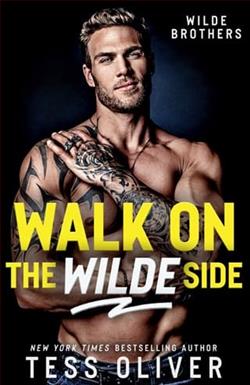Page 75 of The Stranger in Her House
He turns his head to the police and yells, ‘There’s only one way you and I can reach a satisfactory conclusion to our story. And that’s with her down there and not up here.’
It all happens so quickly I don’t have time to process what he means until I recognise the approaching vehicle isn’t a police car, but a train. And Paul has been looking at his watch because he’s been waiting for it to appear.
He drops the knife, slips his hands either side of my waist, then hoists me higher against the bridge wall so that my feet are no longer touching the ground. The officers must realise what he’s about to do because they rush towards us.
They are not fast enough.
With all his strength and mad determination, Paul throws me over the side of the bridge and straight into the path of the speeding train below.
PART THREE
CHAPTER 63
EIGHT MONTHS LATER – REVEREND EDDIE EDWARDS
The congregation joins me in song for the final hymn of this morning’s funeral service. There are only four verses to ‘Abide With Me’ but I take the opportunity to perform a headcount. I stop when I reach a hundred. This is by far the largest number we’ve had under our roof since the Christingle service was filmed forSongs of Praisea decade ago. I think the newspaper and television coverage of her story has brought a lot of journalists here, alongside those who knew her and others who simply want to experience the thrill of being part of a media circus. But if it means the collection tin is full at the end of the day, then who am I to complain?
This service has been relatively short, even with the inclusion of three hymns. Last night, my timed rehearsal came in at a little over twenty minutes. Most are double that, or longer if you include readings and recollections. But though she made some friends here, little was actually known about her. That makes my role more challenging. So I brought to mind a few memories of my own and padded my words out with the usual tropes, such as‘living a vibrant and colourful life’ and ‘always putting her love for others above her own needs’. It’s not as personal as I’d have liked, but I’ve done my best.
I chose not to dwell too much on the circumstances surrounding her death. Everyone knows what happened, they don’t need to hear me rehashing it. Joe and Mary Lawson paid their own tribute and made sure to mention Walter. His death was just as tragic and shocking as the others, but he hasn’t received half the press attention. If he’s not being omitted from the newspaper stories, then he’s relegated to a footnote. He deserved better and now he has it, next to Him.
The hymn draws to an end and I begin to wrap things up. I speak of God’s promises and of the hope that death is not the end. Even if those listening don’t necessarily agree with my belief of what happens to us next, I hope my words might still bring them a little comfort. The Lord’s Prayer follows and it always delights me how so many know the words off by heart and without reading them from the Order of Service cards, especially when most have barely set foot in a church for most of their adult lives.
With perfect timing, the funeral director’s four immaculately dressed pallbearers return to lift the coffin on to their shoulders and make their return journey along the aisle and out of the doors. June, our organist, accompanies us with ‘Guide Me O Thou Great Redeemer’ as I follow them outside and into the church grounds.
It’s a short walk to the plot where she is to be buried. To my left and on the pavement outside the church grounds, three cameramen are filming us and a handful of photographers are pointing their lenses in our direction. I try to ignore them. Wreaths are removed from the lid of the coffin, and as she is lowered slowly into the ground, I begin Psalm 23, which most people here will know as ‘The Lord Is My Shepherd’. Finally, I use the words that have been spoken for centuries before me, and I hope for the centuriesto follow. ‘Earth to earth, ashes to ashes, dust to dust: in sure and certain hope of the resurrection to eternal life through our Lord Jesus Christ.’
And with that, handshakes and fragmented conversations follow, marking the end of my role. I’ve been invited to join them for the wake at the Horse & Hatchet, so once I have hung up my alb and stole in the vestry, I’ll make my way there.
Back inside the church, I hope my service has gone some way to remembering the person and not the manner in which she died.
Her funeral ticked a couple of boxes of firsts for me. It was the first that I have either attended or officiated that has been crowdfunded. In fact, I had never even heard of such a thing until Zainab and her daughter set up a Facebook page to promote it. More than £8,000 was raised by the villagers and others who’d read the story online, all wanting to give her the final resting place she deserved.
It’s also a first because I have never buried anyone who has been buried before. But once Gwen’s body had been exhumed and released by the coroner, she was brought to where she was meant to be, reunited with her husband Bill in a plot adjacent to his.
I turn my head, and through the doors I spot Connie, supported by Zainab and her daughter. She is leaning on her walking frame, taking one step at a time. She catches sight of me and offers a grateful nod. I hope I have done both her and Gwen proud.
CHAPTER 64
CONNIE
It doesn’t matter where I go this morning, my phone is not leaving my sight. I know it’s unlikely to ring until at least the afternoon, but I don’t care. I need to have it with me. I glance at the time as I have done every few minutes since waking up at dawn. It’s still not even 10 a.m. I let out a long, frustrated groan. Today is the first day of Paul Michael’s trial and the uncertainty of it all is already killing me.
He has pleaded ‘not guilty’ to the unlawful killings of Alice McKenzie, Lucy Holden, Walter Clark, Gwen Wright and Fran Brown. And as he suspected on the night when he tried to add me to his scorecard eight months ago, it was Fran’s toxicology report that got the ball rolling. It confirmed she had been drugged with Omixinol, the psychoactive medication. And once the other women’s bodies were exhumed, traces were found in all but the first, Eliza Holmes. Too much time had passed for her body to have retained that vital evidence.
Paul has also pleaded ‘not guilty’ to attempting to murder me. Every time I replay that moment – which, as you might imagine,is many times, daily – I think of how easily I could’ve been another victim. Although I suppose I am a victim, of sorts, just not in the way Paul intended. If he’d had his way, I’d be six feet under with my body parts taped together.
When I was convinced he’d been following me to and from Meredith’s house, it wasn’t paranoia but canny intuition. Despite my best efforts to keep safe, he’d been lurking in the shadows, waiting for his moment. CCTV cameras attached to shops, doorbells and inside a passing taxi proved he had actually been following me from the moment I left Avringstone. And according to his phone records, on my return journey home, he had logged on to the train’s wi-fi to look up its timetable and then Network Rail’s private intranet to discover the exact positioning of bridges on our journey. Of all the jobs he told people he did, railway maintenance and track installation turned out to be the truth. So he knew many routes across the Midlands like the back of his hand. Further evidence against him included train CCTV capturing him paying two teenage girls to walk up and down pressing panic alarm buttons. When the guard and driver assumed there was a technical problem and aborted the journey, Paul had pushed the emergency exit button to ensure he was first to disembark, then waited for the rest of the doors to open and watched from a distance as I left.
While he hadn’t anticipated me wearing a personal alarm or the arrival of the police, he had timed my fall to perfection, stalling the officers on top of the bridge until the train appeared. But what his research hadn’t told him was which track the train would be travelling along. At night and with its glaring lights, he assumed he was throwing me on to the correct track. But he was unaware the train had switched tracks before passing Favrington. He’d inadvertently hurled me sixteen feet below on to an empty line, albeit a hair’s breadth from that high-speed train.
It all happened so quickly that I remember very little about the fall itself, other than the brief, sudden weightlessness. I recall hitting the metal rails on the left side of my body, my hip and arm connecting with it first, followed by my skull. I don’t know if the impact affected my vision or if I was losing consciousness, but the train’s lights seemed to disappear. The last thing I recall is the deafening sound of its brakes as it screamed to a halt, followed by blackness, then nothing else.
Nine days passed before doctors in my ICU team brought me out of my medically induced coma. Regaining consciousness was a gradual process, like swimming from deep water back to the surface of an ocean. So many parts of my body felt heavy, like rocks had been attached to them. Machines beeped and ventilators whooshed all around me, tubes were stuck in my veins and down my throat and I could pee myself but I never felt wet. As they gradually lowered my medication, it took me a few days to become completely aware of my situation. Then memories of Paul’s attack returned to me like I was being handed pieces of a jigsaw. I began slotting them together one by one with the help of Krisha and her colleagues. My care team explained how my shattered hip had been artificially rebuilt, that my broken femur had been repaired and two breaks in my jaw sealed. My ankle, arm and wrist were in plaster casts with metal rods jutting out each side. Other injuries added to my tally included multiple fractured ribs, two cracked vertebrae and three missing molars. How I survived or am able to walk is beyond me.
Hospital became my home for a little over six months, and today marks my eighth week of freedom since being discharged. As an outpatient, I have regular physiotherapy sessions along with regular check-ups from specialists with different areas of expertise. I’m no longer in plaster but I’m aware of the thrumming and hot jabs of pain in various parts of my body. They’ve put me on a low level of meds but I’ve been warned opioids are addictive so theywon’t keep me on them forever. Eventually, they’ll refer me to one of those pain management clinics.
There’s a long list of other after-effects from that night. I have balance issues and I’m often stumbling around like a dozy toddler. My leg muscles are weak so I need to retrain them. And for now, I’m forced to use a walker. Well, they call it a mobility rollator, but everyone knows it’s actually a walking frame with wheels. But it’s temporary, and if I put in the hard work with physio and exercise, I could be walking with a crutch within a month or so.















